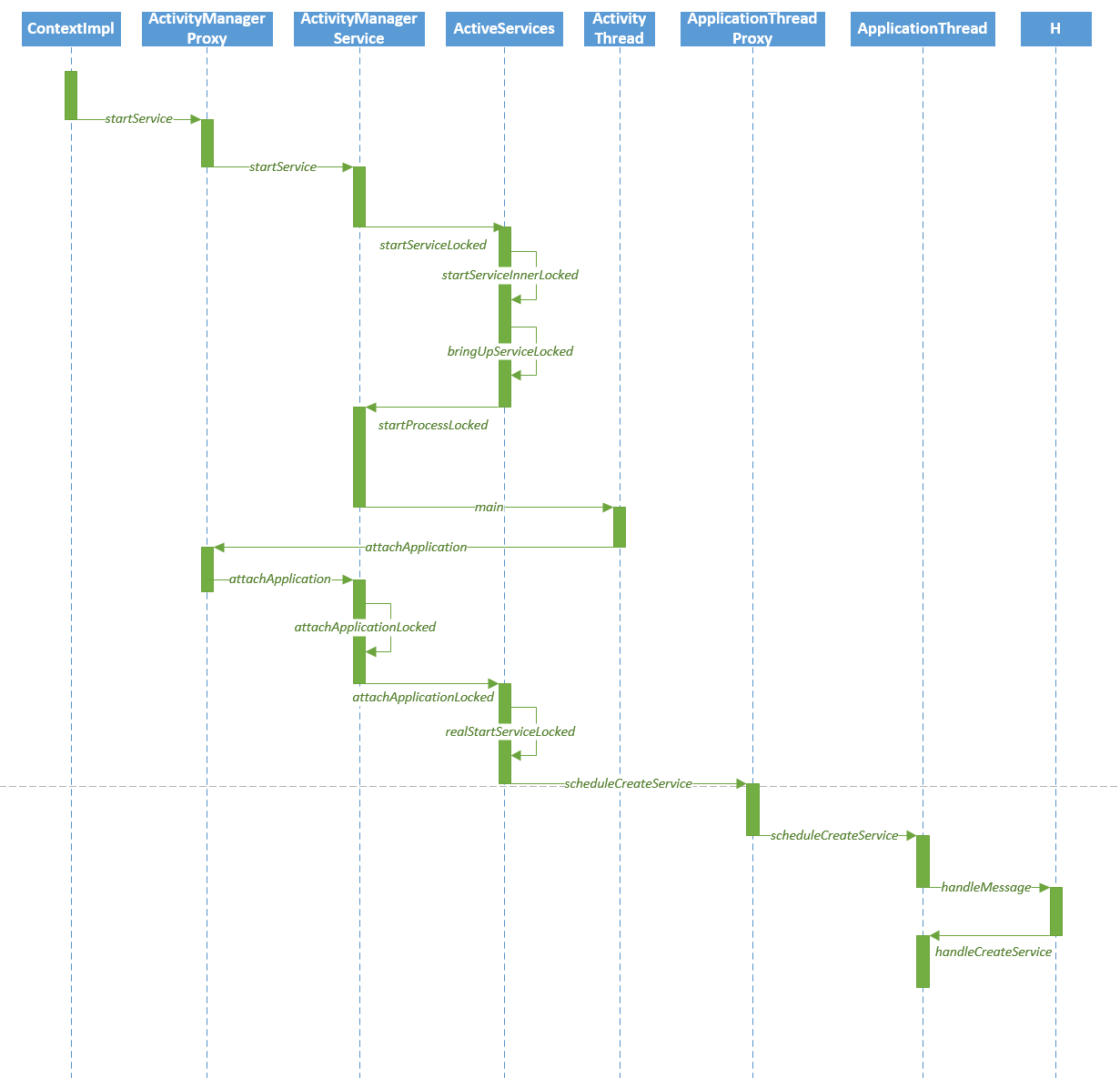Service启动流程
Service启动流程从整个宏观上来看,它的模型如下

startService启动流程时序图

Activity中使用的startService方法是定义在Context的抽象类中,它的真正实现者是ContextImpl,所以我们首先进入ContextImpl类
(1)ContextImpl.startService()
frameworks/base/core/java/android/app/ContextImpl.java
@Override public ComponentName startService(Intent service) { warnIfCallingFromSystemProcess(); return startServiceCommon(service, mUser); } private ComponentName startServiceCommon(Intent service, UserHandle user) { try { validateServiceIntent(service); service.prepareToLeaveProcess(); ComponentName cn = ActivityManagerNative.getDefault().startService( mMainThread.getApplicationThread(), service, service.resolveTypeIfNeeded(getContentResolver()), user.getIdentifier()); //...... return cn; } catch (RemoteException e) { return null; } }
从ContextImpl类的startService开始,然后进入本类的startServiceCommon方法,并最终调用ActivityManagerNative.getDefault()对象的startService方法。其实这里的ActivityManagerNative.getDefault()就是ActivityManagerProxy对象
(2)ActivityManagerProxy.startService()
源码:frameworks/base/core/java/android/app/ActivityManagerNative.java
public ComponentName startService(IApplicationThread caller, Intent service, String resolvedType, int userId) throws RemoteException { Parcel data = Parcel.obtain(); Parcel reply = Parcel.obtain(); data.writeInterfaceToken(IActivityManager.descriptor); data.writeStrongBinder(caller != null ? caller.asBinder() : null); service.writeToParcel(data, 0); data.writeString(resolvedType); data.writeInt(userId); mRemote.transact(START_SERVICE_TRANSACTION, data, reply, 0); reply.readException(); ComponentName res = ComponentName.readFromParcel(reply); data.recycle(); reply.recycle(); return res; }
通过Binder调用ActivityManagerNative类中onTransact方法,其识别码为START_SERVICE_TRANSACTION,并最终调用ActivityManagerNative的实现类ActivityManagerService的startService方法。
(3)ActivityManagerService.startService()
源码:frameworks/base/services/java/com/android/server/am/ActivityManagerService.java
@Override public ComponentName startService(IApplicationThread caller, Intent service, String resolvedType, int userId) { enforceNotIsolatedCaller("startService"); //...... synchronized(this) { final int callingPid = Binder.getCallingPid(); final int callingUid = Binder.getCallingUid(); final long origId = Binder.clearCallingIdentity(); ComponentName res = mServices.startServiceLocked(caller, service, resolvedType, callingPid, callingUid, userId); Binder.restoreCallingIdentity(origId); return res; } }
在这里调用mServices对象的startServiceLocked方法,这里的mServices对象是ActiveServices类。
(4)ActiveServices.startServiceLocked()
源码:frameworks/base/services/java/com/android/server/am/ActiveServices.java
ComponentName startServiceLocked(IApplicationThread caller, Intent service, String resolvedType, int callingPid, int callingUid, int userId) { //...... ServiceLookupResult res = retrieveServiceLocked(service, resolvedType, callingPid, callingUid, userId, true, callerFg); ServiceRecord r = res.record; //...... return startServiceInnerLocked(smap, service, r, callerFg, addToStarting); }
相关内容,然后将解析结果放在res.record中,最后在调用startServiceInnerLocked方法。
(5)ActiveServices.startServiceInnerLocked()
源码:frameworks/base/services/java/com/android/server/am/ActiveServices.java
ComponentName startServiceInnerLocked(ServiceMap smap, Intent service, ServiceRecord r, boolean callerFg, boolean addToStarting) { //...... synchronized (r.stats.getBatteryStats()) { r.stats.startRunningLocked(); } String error = bringUpServiceLocked(r, service.getFlags(), callerFg, false); //...... }
这里紧接着会调用bringUpServiceLocked方法。
(6)ActiveServices.bringUpServiceLocked()
源码:frameworks/base/services/java/com/android/server/am/ActiveServices.java
private final String bringUpServiceLocked(ServiceRecord r, int intentFlags, boolean execInFg, boolean whileRestarting) { //(1)这里如果当前的ProcessRecord不为null,那就不需要重新创建进程,而是调用realStartServiceLocked方法来启动Service if (app != null && app.thread != null) { try { app.addPackage(r.appInfo.packageName, r.appInfo.versionCode, mAm.mProcessStats); realStartServiceLocked(r, app, execInFg); return null; } catch (RemoteException e) { Slog.w(TAG, "Exception when starting service " + r.shortName, e); } // If a dead object exception was thrown -- fall through to // restart the application. } //(2)如果是需要创建新进程,那么将调用ActivityManagerService.startProcessLocked方法来启动新进程 if (app == null) { if ((app=mAm.startProcessLocked(procName, r.appInfo, true, intentFlags, "service", r.name, false, isolated, false)) == null) { //...... bringDownServiceLocked(r); return msg; } if (isolated) { r.isolatedProc = app; } } //最后将ServiceRecord保存到成员变量mPendingServices中 if (!mPendingServices.contains(r)) { mPendingServices.add(r); } }
这个方法比较重要,这里有两种选择,当Service所在的进程存在时,将调用realStartServiceLocked方法来启动Service,否则的话调用startProcessLocked方法来启动新进程。
(7)ActivityManagerService.startProcessLocked()
源码:frameworks/base/services/java/com/android/server/am/ActivityManagerService.java
private final void startProcessLocked(ProcessRecord app, String hostingType, String hostingNameStr, String abiOverride, String entryPoint, String[] entryPointArgs) { boolean isActivityProcess = (entryPoint == null); if (entryPoint == null) entryPoint = "android.app.ActivityThread"; checkTime(startTime, "startProcess: asking zygote to start proc"); //通过processName,uid等启动新进程 Process.ProcessStartResult startResult = Process.start(entryPoint, app.processName, uid, uid, gids, debugFlags, mountExternal, app.info.targetSdkVersion, app.info.seinfo, requiredAbi, instructionSet, app.info.dataDir, entryPointArgs); }
这里通过Process的start方法启动ActivityThread的新进程,我们进入该类的main方法。
(8)ActivityThread.main()
源码:frameworks/base/core/java/android/app/ActivityThread.java
public static void main(String[] args) { //...... Process.setArgV0("<pre-initialized>"); Looper.prepareMainLooper(); //创建ActivityThread对象,并调用其attach方法 ActivityThread thread = new ActivityThread(); thread.attach(false); if (sMainThreadHandler == null) { sMainThreadHandler = thread.getHandler(); } if (false) { Looper.myLooper().setMessageLogging(new LogPrinter(Log.DEBUG, "ActivityThread")); } Looper.loop(); throw new RuntimeException("Main thread loop unexpectedly exited"); } private void attach(boolean system) { final IActivityManager mgr = ActivityManagerNative.getDefault(); try { //这里调用了ActivityManagerProxy.attachApplication方法。 mgr.attachApplication(mAppThread); } catch (RemoteException ex) { // Ignore } }
在Android应用程序中,每一个进程对应一个ActivityThread实例,然后这里创建了ActivityThread对象并调用了其attach方法,在attach方法中又调用了ActivityManagerProxy.attachApplication方法。
(9)ActivityManagerProxy.attachApplication()
源码:frameworks/base/core/java/android/app/ActivityManagerNative.java
public void attachApplication(IApplicationThread app) throws RemoteException { Parcel data = Parcel.obtain(); Parcel reply = Parcel.obtain(); data.writeInterfaceToken(IActivityManager.descriptor); data.writeStrongBinder(app.asBinder()); mRemote.transact(ATTACH_APPLICATION_TRANSACTION, data, reply, 0); reply.readException(); data.recycle(); reply.recycle(); }
通过Binder机制会调用ActivityManagerNative中的onTransact方法,其识别码为ATTACH_APPLICATION_TRANSACTION,并最终调用ActivityManagerService中的attachApplication方法。
(10)ActivityManagerService.attachApplication()
源码:frameworks/base/services/java/com/android/server/am/ActivityManagerService.java
@Override public final void attachApplication(IApplicationThread thread) { synchronized (this) { int callingPid = Binder.getCallingPid(); final long origId = Binder.clearCallingIdentity(); attachApplicationLocked(thread, callingPid); Binder.restoreCallingIdentity(origId); //...... } }
这里调用attachApplicationLocked方法来进一步处理。
(11)ActivityManagerService.attachApplicationLocked()
源码:frameworks/base/services/java/com/android/server/am/ActivityManagerService.java
private final boolean attachApplicationLocked(IApplicationThread thread, int pid) { // See if the top visible activity is waiting to run in this process... if (normalMode) { try { if (mStackSupervisor.attachApplicationLocked(app)) { didSomething = true; } } catch (Exception e) { Slog.wtf(TAG, "Exception thrown launching activities in " + app, e); badApp = true; } } // Find any services that should be running in this process... if (!badApp) { try { //这里会调用ActiveServices对象的attachApplicationLocked方法 didSomething |= mServices.attachApplicationLocked(app, processName); } catch (Exception e) { Slog.wtf(TAG, "Exception thrown starting services in " + app, e); badApp = true; } } }
里如果是启动Service将调用ActiveServices对象的attachApplicationLocked方法,而如果是启动Activity将调用ActivityStackSupervisor对象的attachApplicationLocked方法。
(12)ActiveServices.attachApplicationLocked()
源码:frameworks/base/services/java/com/android/server/am/ActiveServices.java
boolean attachApplicationLocked(ProcessRecord proc, String processName) throws RemoteException { boolean didSomething = false; // Collect any services that are waiting for this process to come up. if (mPendingServices.size() > 0) { ServiceRecord sr = null; try { for (int i=0; i<mPendingServices.size(); i++) { sr = mPendingServices.get(i); if (proc != sr.isolatedProc && (proc.uid != sr.appInfo.uid || !processName.equals(sr.processName))) { continue; } mPendingServices.remove(i); i--; proc.addPackage(sr.appInfo.packageName, sr.appInfo.versionCode,mAm.mProcessStats); //这里调用realStartServiceLocked方法 realStartServiceLocked(sr, proc, sr.createdFromFg); didSomething = true; } } catch (RemoteException e) { Slog.w(TAG, "Exception in new application when starting service "+ sr.shortName, e); throw e; } } //...... }
(13)ActiveServices.realStartServiceLocked()
源码:frameworks/base/services/java/com/android/server/am/ActiveServices.java
private final void realStartServiceLocked(ServiceRecord r, ProcessRecord app, boolean execInFg) throws RemoteException { if (app.thread == null) { throw new RemoteException(); } //...... app.thread.scheduleCreateService(r, r.serviceInfo, mAm.compatibilityInfoForPackageLocked(r.serviceInfo.applicationInfo), app.repProcState); }
此处的app.thread是一个IApplicationThread对象,而IApplicationThread的代理类是ApplicationThreadProxy,我们进入app.thread对象的scheduleCreateService方法。
(14)ApplicationThreadProxy.scheduleCreateService()
源码:frameworks/base/core/java/android/app/ApplicationThreadNative.java
public final void scheduleCreateService(IBinder token, ServiceInfo info, CompatibilityInfo compatInfo, int processState) throws RemoteException { Parcel data = Parcel.obtain(); data.writeInterfaceToken(IApplicationThread.descriptor); data.writeStrongBinder(token); info.writeToParcel(data, 0); compatInfo.writeToParcel(data, 0); data.writeInt(processState); mRemote.transact(SCHEDULE_CREATE_SERVICE_TRANSACTION, data, null, IBinder.FLAG_ONEWAY); data.recycle(); }
通过Binder对象调用ApplicationThreadNative的onTransact方法,在其方法中调用子类的scheduleCreateService方法,即最终调用ApplicationThreadNative的子类ApplicationThread的scheduleCreateService方法。
(15)ApplicationThread.scheduleCreateService()
源码:frameworks/base/core/java/android/app/ActivityThread.java
public final void scheduleCreateService(IBinder token, ServiceInfo info, CompatibilityInfo compatInfo, int processState) { updateProcessState(processState, false); CreateServiceData s = new CreateServiceData(); s.token = token; s.info = info; s.compatInfo = compatInfo; sendMessage(H.CREATE_SERVICE, s); }
通过Handler发送Message来处理该操作,并进入到H的handleMessage方法中,其识别码为CREATE_SERVICE。
(16)H.handleMessage()
源码:frameworks/base/core/java/android/app/ApplicationThread.java
private class H extends Handler { public void handleMessage(Message msg) { Trace.traceBegin(Trace.TRACE_TAG_ACTIVITY_MANAGER, "serviceCreate"); //这里调用handleCreateService方法 handleCreateService((CreateServiceData)msg.obj); Trace.traceEnd(Trace.TRACE_TAG_ACTIVITY_MANAGER); } }
我们继续进入handleCreateService方法。
(17)ApplicationThread.handleCreateService()
源码:frameworks/base/core/java/android/app/ActivityThread.java
private void handleCreateService(CreateServiceData data) { Service service = null; try { //(1)通过类加载器来加载Service对象 java.lang.ClassLoader cl = packageInfo.getClassLoader(); service = (Service) cl.loadClass(data.info.name).newInstance(); } catch (Exception e) { //...... } //(2)这里创建ContextImpl对象 ContextImpl context = ContextImpl.createAppContext(this, packageInfo); context.setOuterContext(service); Application app = packageInfo.makeApplication(false, mInstrumentation); service.attach(context, this, data.info.name, data.token, app, ActivityManagerNative.getDefault()); //(3)这里调用Service的onCreate方法 service.onCreate(); mServices.put(data.token, service); }
1)处通过类加载器ClassLoader来加载Service对象,此处的data.info.name就是我们要启动的Service,加载完成后需要将其强转换为Service对象,也就是说我们的Service必须要继承于Service基类。
(2)处这里先创建一个ContextImpl对象,每个Activity和Service都有一个Context对象。
(3)处这里调用Service的OnCreate方法。
好啦,到此整个Service通过startService的方式就启动起来了,接下来我们总结一下步骤。
总结

1、(1)-(7)从主进程调用到ActivityManagerService进程中,并调用其startProcessLocked方法来启动新的进程。
2、(8)-(11)从新进程调用到ActivityManagerService进程中,获取要启动的服务的相关信息。
3、(12)-(17)从ActivityManagerService进程回到新进程中并最终将服务启动起来。



